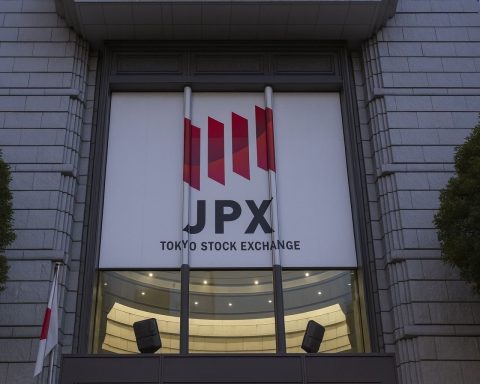Japan’s stock market heads into the three‑day weekend under pressure after a bruising Friday session that capped a volatile week for Tokyo equities.
On Friday, November 21, the Nikkei 225 closed at 48,625.88, down 1,198 points (‑2.4%) from the previous session, while the broader Topix index dipped to 3,297.73, effectively flat on the day but marginally lower. [1]
For the week, the Nikkei fell about 3.5%, with the Topix down roughly 1.8%, extending a slide from record highs as tech stocks, a slumping yen and rising bond yields all weighed on sentiment. [2]
At the same time, markets are trying to digest Prime Minister Sanae Takaichi’s ¥21.3 trillion (about $135 billion) stimulus package, the largest since the pandemic, alongside growing signals that the Bank of Japan (BOJ) could deliver a rate hike as soon as December. [3]
Below is a detailed wrap of what moved Japanese stocks on November 21 and what it means for investors following Japan’s market today, November 22, 2025.
Nikkei 225 and Topix: Tech‑Led Sell‑Off Caps a Weak Week
Friday’s declines were concentrated in technology and growth shares, mirroring an abrupt reversal in U.S. AI and chip names after investors questioned high valuations even following blockbuster earnings from Nvidia. [4]
Key points from Friday’s session:
- Headline performance
- Breadth and sectors
- Reuters data show the Nikkei fell 2.4% on Friday and 3.5% for the week, with the Topix edging down 0.1% on the day and losing almost 2% over five sessions. [7]
- Heavyweight tech and AI‑related names bore the brunt of the selling as investors took profits after a powerful rally and reacted to the U.S. tech pullback. [8]
- Intraday volatility
- Xinhua reports that at one point during the session the Nikkei was more than 1,300 points lower before paring some losses into the close, underscoring just how nervous the market has become. [9]
- The fall was also framed as a partial correction to Thursday’s sharp rebound, with many investors reluctant to add risk ahead of a three‑day holiday weekend in Japan. [10]
Put simply: Japan stock market today is in “risk‑off” mode. The Nikkei is still not far from multi‑decade highs, but the tone has shifted from euphoria to caution as global tech jitters collide with home‑grown macro worries.
Global Tech Jitters Meet Japan’s Own “Triple Blow”
Friday’s sell‑off didn’t come out of nowhere. It capped a week that saw:
- A tech‑driven global correction, especially in AI leaders.
- Rising worries about higher‑for‑longer interest rates worldwide.
- Mounting concern over Japan’s fiscal and monetary path.
Earlier in the week, a Reuters “Trading Day” column described Tuesday as a “bleak day” for Japanese assets, with the Nikkei down about 3%, the yen at a nine‑month low against the dollar and long‑dated Japanese government bond (JGB) yields at record levels, all tied to what the author called “fiscal fear” around heavier borrowing. [11]
Chinese state‑backed outlet CGTN went further, arguing that Japan is facing a “triple blow” to stocks, bonds and the yen, driven by aggressive fiscal expansion and diplomatic tensions, with 40‑year JGB yields climbing above 3.69% and 10‑year yields hitting their highest level since the global financial crisis. [12]
Whether or not you buy that “debt crisis” framing, the message for equity investors is clear:
The Japan stock market is no longer trading only on earnings and AI hype – it is suddenly very sensitive to macro and policy risk.
Takaichi’s ¥21.3 Trillion Stimulus: Relief for Households, Jitters for Markets
The biggest domestic story for Japan stocks on November 21–22 is the new stimulus package from Prime Minister Sanae Takaichi’s government.
What’s in the package?
Across multiple outlets – Reuters, AP, the Financial Times and domestic media – the broad contours are consistent: [13]
- Total size:
- ¥21.3 trillion (about $135 billion–$136 billion) – the largest stimulus since the COVID‑19 pandemic.
- Composition:
- Around ¥17.7 trillion in general account spending.
- Roughly ¥2.7 trillion in tax cuts, plus about ¥0.9 trillion from special accounts, according to the Japan Times. [14]
- Key measures:
- Energy subsidies for gas and electricity bills.
- One‑off cash handouts to households with children (reports commonly cite ¥20,000 per child). [15]
- Temporary cuts or abolition of the gasoline tax and tweaks to the income tax threshold. [16]
- Support for strategic sectors, including semiconductors, AI and national security‑linked industries such as shipbuilding. [17]
The government’s own estimates suggest the package could lift GDP by around ¥24 trillion (roughly 1.4% of annual output) and briefly knock about 0.7 percentage points off headline inflation early next year thanks to energy and fuel subsidies. [18]
Why are markets spooked?
From a market perspective, the problem is not that Tokyo is spending to support households – it’s how big the package is, and how it will be funded.
- Reuters notes that the stimulus is substantially larger than last year’s, and that additional JGB issuance will be needed, even though Takaichi insists total bond sales this fiscal year will still be lower than last year. [19]
- The announcement came alongside the yen sliding to around ¥157 per dollar, a 10‑month low, and super‑long JGB yields hitting record highs, both signs that bond and FX markets are questioning fiscal sustainability. [20]
A sharply critical Reuters Breakingviews column argues that the fiscal “splurge” may backfire by further weakening the yen, raising imported inflation and ultimately forcing the BOJ to tighten more than politicians would like. [21]
CGTN, from a Chinese vantage point, paints an even darker picture, warning that heavy reliance on debt‑financed spending risks trapping Japan in a cycle of rising yields, swelling interest costs and ever‑larger borrowing needs. [22]
For equity investors, the linkage is straightforward:
- More bond supply + higher yields → pressure on growth stocks and richly valued names.
- Weaker yen + imported inflation → greater chance of BOJ rate hikes → higher discount rates for equities.
That combination showed up clearly in Friday’s 2.4% drop in the Nikkei 225, led by tech and high‑multiple names. [23]
Bank of Japan: December Meeting Suddenly Looks “Live”
If fiscal policy is stepping on the gas, monetary policy may be preparing to tap the brakes.
Ueda signals a possible December hike
On Friday, BOJ Governor Kazuo Ueda delivered his clearest hint yet that the central bank could raise interest rates at its December 18–19 meeting:
- He told parliament the BOJ would debate the “feasibility and timing” of a rate hike in coming meetings, a notable shift from previous “no preset timing” language. [24]
- Ueda said he wants “just a bit more data” on next year’s wage trends but warned that the weak yen could now have a bigger and more lasting impact on underlying inflation than in the past. [25]
The yen’s slide to a 10‑month low has become politically sensitive, raising import prices for energy and food and prompting Finance Minister Satsuki Katayama to step up warnings of possible FX intervention. [26]
Masu: “We’re close” to another rate hike
Ueda’s remarks were reinforced over the weekend by new BOJ board member Kazuyuki Masu, who told the Nikkei and Jiji that: [27]
- The BOJ is “nearing” a decision to raise rates and does not intend to wait until after next spring’s wage negotiations conclude.
- The economic environment for hiking is already in place, and a move at the December meeting is possible unless incoming data deteriorate sharply.
- Keeping real borrowing costs deeply negative for too long risks distorting asset prices, including real estate.
Other board members, such as Junko Koeda, have also leaned hawkish, arguing the BOJ should continue to raise real interest rates given persistent price pressures. [28]
What this means for Japan stocks
For the Japan stock market today, the BOJ narrative matters in three main ways:
- Discount rates – Even modest rate hikes can affect equity valuations, especially for the growth and tech names that powered the Nikkei’s earlier surge.
- Yen path – A credible rate‑hike path could eventually stabilize or strengthen the yen, which matters for exporters, imported‑energy costs and foreign investor flows.
- Policy mix – The growing tension between very loose fiscal policy and a more hawkish BOJ is exactly the kind of macro cross‑current that can increase volatility across all Japanese assets.
New Prime Minister Under Market Pressure
Friday’s sell‑off also has a political dimension.
Sanae Takaichi, Japan’s first female prime minister, took office only last month on a platform of expansionary fiscal policy and a willingness to tolerate low interest rates to support growth and defense spending. [29]
But markets are already questioning that stance:
- Bloomberg estimates that roughly $127 billion has been wiped off the value of Tokyo‑listed stocks over the past week, as investors reassess Takaichi’s approach to spending, debt and the BOJ. [30]
- The same piece notes sharp declines in the yen and JGBs alongside the equity sell‑off, highlighting how quickly investor goodwill can evaporate when fiscal risks rise. [31]
Domestic and international commentary is increasingly pointed:
- Reuters Breakingviews argues that Takaichi’s large‑scale stimulus risks weakening the yen, negating the benefits of subsidies and ultimately forcing the BOJ to hike more aggressively, undermining her goal of keeping funding costs low. [32]
- CGTN casts her policies and recent hawkish remarks on Taiwan as catalysts for Japan’s alleged “triple blow” to stocks, bonds and FX, tying domestic market stress to geopolitical tensions. [33]
Whether one sees that as overdone or not, the key takeaway for anyone tracking Japan stock market news is:
Takaichi’s fiscal choices and her relationship with the BOJ are now central market drivers, not background noise.
Yen, Bonds and Intervention Talk: Macro Backdrop for Equities
Even though equities get the headlines, the real action this week has been in the yen and JGBs, and that backdrop is crucial for stock investors.
Yen near intervention zone
Reuters reports that: [34]
- The dollar/yen pair is hovering in the mid‑¥150s, not far from the ¥160 zone where many analysts believe the risk of FX intervention rises sharply.
- Analysts at major banks warn that if authorities do not step in around 158–162, traders might test ¥165 per dollar, especially since speculative positioning in the yen is relatively light this time.
- Past interventions (2022 and 2024) had mixed success; without a BOJ rate hike, any yen‑buying could prove short‑lived.
JGB yields at or near record highs
At the same time:
- 30‑ and 40‑year JGB yields have surged to all‑time highs on concerns that funding the new stimulus will require heavier borrowing, according to Reuters and CGTN. [35]
- Even the 10‑year yield has climbed to its highest since the late 2000s, a striking move for what was, until recently, one of the world’s lowest‑yielding sovereign curves. [36]
For stocks, that combination – weak yen, high long‑end yields – is toxic for:
- Long‑duration growth and tech names, whose valuations are most sensitive to discount‑rate changes.
- Highly leveraged sectors, which face higher refinancing costs if yields stay elevated.
- Domestically oriented companies exposed to rising input prices via the weaker currency.
How Futures and Overseas Trading Are Framing the Weekend
While Tokyo’s cash market is closed on Saturday, overseas trading gives a hint of how global investors are positioning around Japan.
- Associated Press futures data cited on U.S. local media shows Nikkei 225 futures on the CME changing hands in healthy volume on Friday evening U.S. time, reflecting ongoing repositioning after the sharp cash‑market drop. [37]
- CME’s own product pages highlight deep liquidity and around‑the‑clock trading in yen‑denominated Nikkei futures, making it easy for global funds to express views on Japan even while the Tokyo Stock Exchange is closed. [38]
Price indications from futures suggest some stabilization, but not a decisive bullish reversal, heading into next week – consistent with a market that is trying to find a floor while still grappling with macro uncertainty.
What to Watch Next Week for Japan Stocks
For readers following Japan stock market today and planning for the week ahead, several catalysts stand out:
- BOJ December Meeting Expectations
- Markets now see the December 18–19 policy meeting as “live,” with a meaningful chance of a rate hike, according to multiple Reuters reports. [39]
- Any fresh comments from Ueda or other BOJ board members will be dissected for clues on timing and pace.
- Supplementary Budget and Diet Debate
- The government aims to approve a supplementary budget to fund the ¥21.3 trillion package by late November and push it through parliament by year‑end. [40]
- The details of bond issuance and the political fight over “fiscal responsibility” will matter for both the yenand JGB yields – and by extension, for equities.
- Yen Around ¥160
- Analysts increasingly treat ¥160 per dollar as a psychological line in the sand for intervention risk. [41]
- A break and hold above that level without credible policy response could add another leg to the equity sell‑off.
- Global Tech and AI Sentiment
- Japan’s market is now tightly linked to global tech and AI cycles; any further weakness in U.S. megacaps or AI leaders can easily spill over into Tokyo’s chip and internet stocks. [42]
- Domestic Data: Inflation and Wages
- With the BOJ explicitly watching wage and inflation dynamics, upcoming data on consumer prices and wage settlements will feed directly into rate expectations – and thus into Nikkei and Topix performance. [43]
Takeaways for Investors Watching the Japan Stock Market Today
Putting it all together:
- Short term:
- The Nikkei 225 is under pressure as tech stocks correct and markets price a tougher policy mix: big fiscal, less ultra‑easy monetary policy.
- Friday’s 2.4% drop and roughly 3.5% weekly loss reflect that repricing. [44]
- Medium term:
- Japan still benefits from corporate reforms, solid earnings in many sectors and long‑term reshoring and friend‑shoring trends, but those positives now compete with:
- A weaker yen flirting with intervention territory.
- Rising JGB yields that could re‑anchor valuation multiples.
- A new prime minister whose first big policy move has rattled, rather than reassured, financial markets. [45]
- Japan still benefits from corporate reforms, solid earnings in many sectors and long‑term reshoring and friend‑shoring trends, but those positives now compete with:
- Key risk to monitor:
- A scenario where bond and currency markets continue to test Japan’s tolerance for higher yields and a weaker yen, forcing either faster BOJ tightening or more aggressive intervention – both of which could trigger further volatility in Japanese equities.
For now, the message from November 21–22 is that Japan’s stock market has entered a more fragile phase, where policy headlines, yen moves and bond yields can matter as much as – or more than – individual company stories.
References
1. en.people.cn, 2. www.brecorder.com, 3. www.reuters.com, 4. www.brecorder.com, 5. fred.stlouisfed.org, 6. en.people.cn, 7. www.brecorder.com, 8. www.brecorder.com, 9. en.people.cn, 10. en.people.cn, 11. www.reuters.com, 12. news.cgtn.com, 13. www.reuters.com, 14. www.reuters.com, 15. apnews.com, 16. www.reuters.com, 17. www.ft.com, 18. apnews.com, 19. www.reuters.com, 20. www.reuters.com, 21. www.reuters.com, 22. news.cgtn.com, 23. en.people.cn, 24. www.reuters.com, 25. www.reuters.com, 26. www.reuters.com, 27. www.reuters.com, 28. www.reuters.com, 29. en.wikipedia.org, 30. www.bloomberg.com, 31. www.bloomberg.com, 32. www.reuters.com, 33. news.cgtn.com, 34. www.reuters.com, 35. www.reuters.com, 36. news.cgtn.com, 37. apnews.com, 38. www.cmegroup.com, 39. www.reuters.com, 40. www.reuters.com, 41. www.reuters.com, 42. www.reuters.com, 43. www.reuters.com, 44. en.people.cn, 45. www.bloomberg.com










